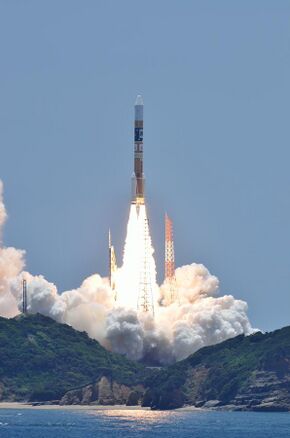Engineering:ALOS-2
 H-IIA Launch Vehicle Flight 24, launching the Advanced Land Observing Satellite-2 "Daichi-2". | |
| Names | Daichi-2 |
|---|---|
| Mission type | Remote sensing |
| Operator | JAXA |
| COSPAR ID | 2014-029A |
| SATCAT no. | 39766 |
| Website | www |
| Mission duration | 10 years, 1 month, 26 days (elapsed) |
| Spacecraft properties | |
| Spacecraft type | Advanced Land Observing Satellite |
| Bus | ALOS |
| Launch mass | 2,120 kg (4,670 lb) |
| Start of mission | |
| Launch date | 24 May 2014, 03:05:14 UTC[1] |
| Rocket | H-IIA 202 |
| Launch site | Tanegashima, Yoshinobu 1 |
| Contractor | Mitsubishi Heavy Industries |
| Orbital parameters | |
| Reference system | Geocentric orbit[2] |
| Regime | Sun-synchronous orbit |
| Perigee altitude | 636 km (395 mi) |
| Apogee altitude | 639 km (397 mi) |
| Inclination | 97.92° |
| Period | 97.33 minutes |
Advanced Land Observation Satellite | |
Advanced Land Observing Satellite-2 (ALOS-2), also called Daichi-2, is a 2,120 kg (4,670 lb) Japanese satellite launched in 2014. Although the predecessor ALOS satellite had featured 2 optical cameras in addition to L-band (1.2 GHz/25 cm) radar, ALOS-2 had optical cameras removed to simplify construction and reduce costs. The PALSAR-2 radar is a significant upgrade of the PALSAR radar, allowing higher-resolution (1 x 3 m per pixel) spotlight modes in addition to the 10 m resolution survey mode inherited from the ALOS spacecraft. Also, the SPAISE2 automatic ship identification system and the Compact Infra Red Camera (CIRC) will provide supplementary data about sea-going ships and provide early warnings of missile launches.[3]
Launch
ALOS-2 was launched from Tanegashima, Japan, on 24 May 2014 by a H-IIA rocket.[4]
Mission
The satellite contains a 1.2 GHz synthetic-aperture radar (SAR) sensor that is intended to be used for cartography, monitoring of naval traffic and disaster monitoring of Asia and the Pacific.[3] JAXA initially hoped to be able to launch the successor to ALOS during 2011, but these plans were delayed until 2014 because of budget restrictions.
See also
- 2014 in spaceflight
- Advanced Land Observation Satellite (ALOS) – predecessor spacecraft
References
- ↑ McDowell, Jonathan. "Launch Log". Jonathan's Space Report. http://planet4589.org/space/log/launchlog.txt.
- ↑ "ALOS 2 Satellite details 2014-029A NORAD 39766". N2YO. 25 January 2015. http://www.n2yo.com/satellite/?s=39766.
- ↑ 3.0 3.1 "Satellite Missions Catalogue: ALOS-2 (Advanced Land Observing Satellite-2) / Daichi-2". eoPortal.org. May 29, 2012. https://www.eoportal.org/satellite-missions/alos-2#palsar-2-phased-array-l-band-synthetic-aperture-radar-2.
- ↑ "Japanese craft launched with night-vision mapping radar", Spaceflight Now, Retrieved on 31 May 2014
External links
- ALOS-2 brochure
- Advanced Land Observing Satellite-2 "ALOS-2" (DAICHI-2) Gazing into Earth's Expression on YouTube by JAXA
- You can understand DAICHI-2 applications for disaster on YouTube by JAXA
- Eoportal ALOS-2 page
 |

